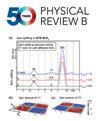Diffusion in liquid metals is directed by competing collective modes
IF 3.7
2区 物理与天体物理
Q1 Physics and Astronomy
引用次数: 0
Abstract
The self-diffusion process in a dense liquid is influenced by collective particle movements. Extensive molecular dynamics simulations for liquid aluminium and rubidium evidence a crossover in the diffusion coefficient at about 1.4 times the melting temperature Tm, indicating a profound change in the diffusion mechanism. The corresponding velocity autocorrelation functions demonstrate a decrease of the cage effect with a gradual set in of a power-law decay, they celebrate long time tail. This behavior is caused by a competition of density fluctuations near the melting point with vortex-type particle patterns from transverse currents in the hot fluid. The investigation of the velocity autocorrelation function evidences a gradual transition in dynamics with rising temperature. The competition between these two collective particle movements, one hindering and one enhancing the diffusion process, leads to a non-Arrhenius-type behavior of the diffusion coefficient around求助全文
约1分钟内获得全文
求助全文
来源期刊

Physical Review B
物理-物理:凝聚态物理
CiteScore
6.70
自引率
32.40%
发文量
0
审稿时长
3.0 months
期刊介绍:
Physical Review B (PRB) is the world’s largest dedicated physics journal, publishing approximately 100 new, high-quality papers each week. The most highly cited journal in condensed matter physics, PRB provides outstanding depth and breadth of coverage, combined with unrivaled context and background for ongoing research by scientists worldwide.
PRB covers the full range of condensed matter, materials physics, and related subfields, including:
-Structure and phase transitions
-Ferroelectrics and multiferroics
-Disordered systems and alloys
-Magnetism
-Superconductivity
-Electronic structure, photonics, and metamaterials
-Semiconductors and mesoscopic systems
-Surfaces, nanoscience, and two-dimensional materials
-Topological states of matter
 求助内容:
求助内容: 应助结果提醒方式:
应助结果提醒方式:


